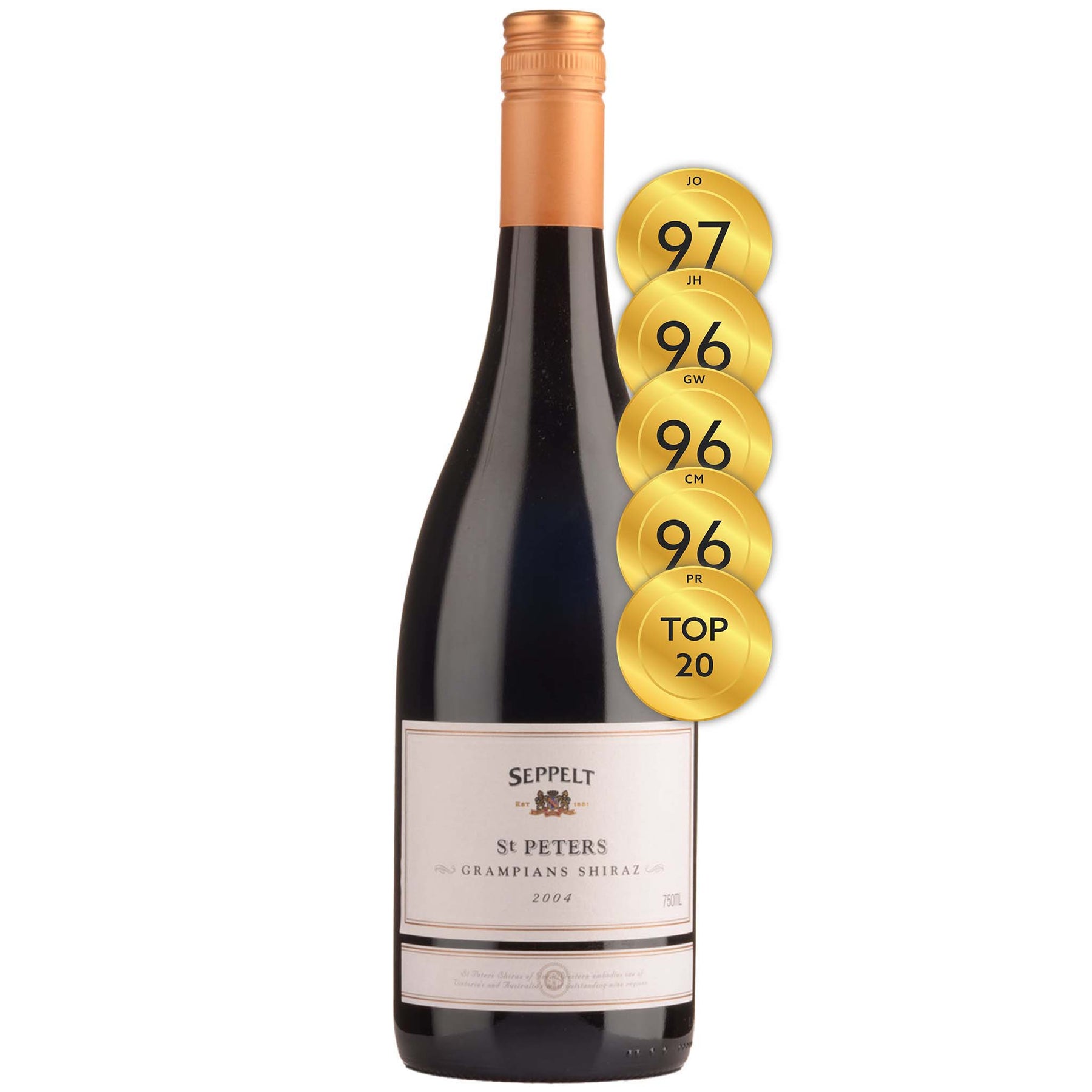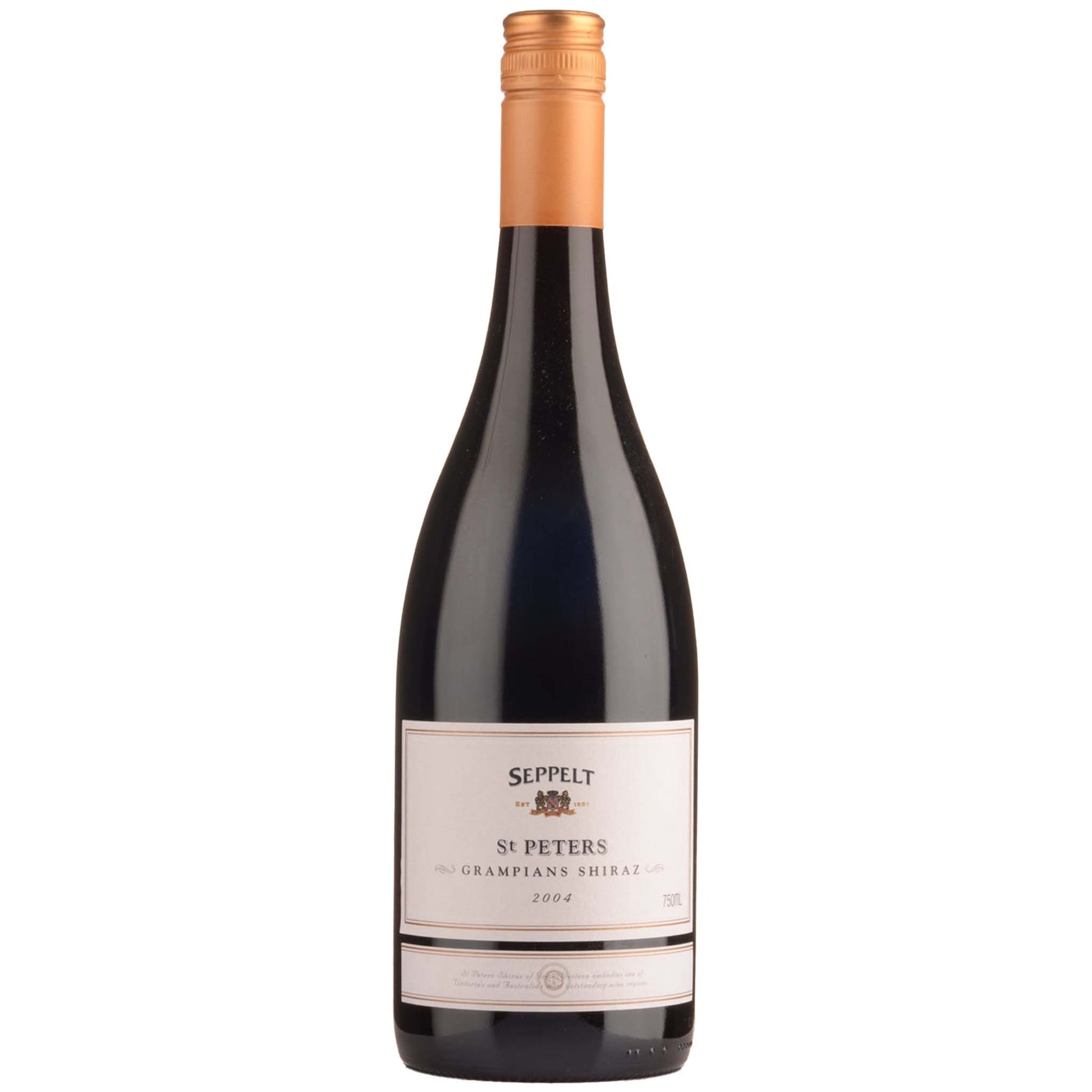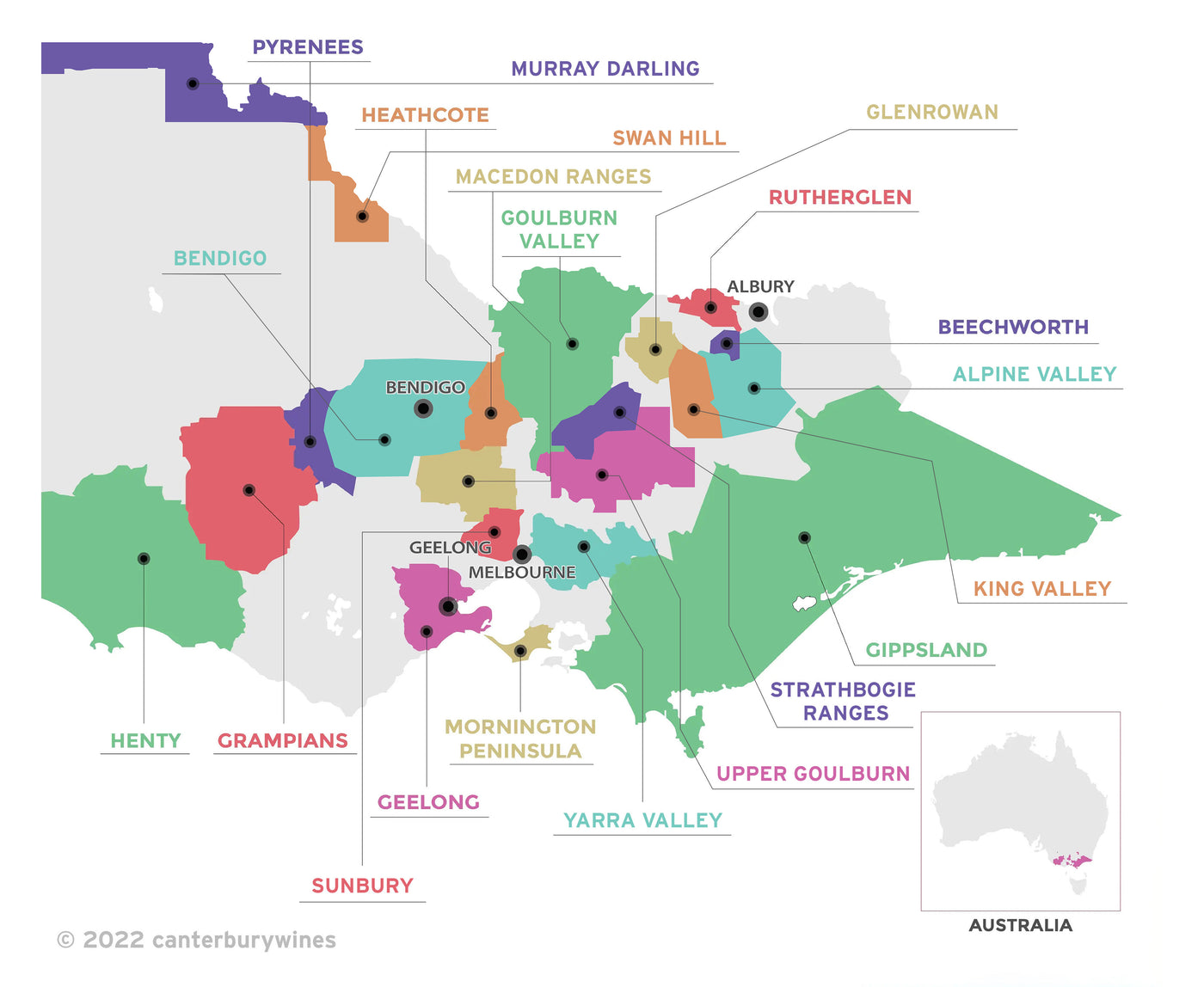

Seppelt St Peters Grampians Shiraz 2004
Style: Red Wine
Closure: Screwcap
Seppelt St Peters Grampians Shiraz 2004
Warehouse
34 Redland Drive
Vermont VIC 3133
Australia
Critic Score: 97
Alcohol: 13.8%
Size: 750 ml
Drink by: 2030
Philip Rich Top 20 Wines of 2006
Released in small quantities and only in exceptional years, St Peters Shiraz is Seppelt's flagship wine, testimony to the distinctive style and pedigree of Grampians Shiraz. The first vintage of this iconic wine was released in 1964 as Seppelt Great Western Hermitage and the name changed to St Peters in 1998 in honour of the historic St Peters vineyard which was the first vineyard planted in the region in 1863. With extraordinary cellaring potential of 50 years or more, this wine is classified 'Outstanding' by Langton's in its classification of Australian Wine.
"The 2004 St Peters Grampians shiraz is one of the greatest Great Western shirazes of recent times: a fabulous spicy Rhone-ish style." Huon Hooke
"The Seppelt Grampians St Peters Shiraz 2004, to be released in September this year, is what I would call Seppelt's first real Grand Cru red wine. More than that: it is the best red wine I have tasted from Seppelt, from any era. 'We've been talking about the concept of Grand Cru in Australia for a while now,' Seppelt Great Western chief winemaker Arthur O'Connor says. '2004 is the wine that we think makes the first real claim at it - or we hope it does.'
I'm a fan of Seppelt Great Western and a fan of that glorious old St Peters vineyard in particular, and in recent years the wines have gone from excellent to even better than that. The 2002 was ripe and luscious and wonderful, though quite heavy on the oak; the 2003 was ripe and structured and full of deep-shot spice; the 2004 is in some ways the two of them combined, the oak soaked thoroughly into the wine, the spice black and crushed and thrilling, the fruit ripe but cut by seams of fruity tannin." Campbell Mattinson
Expert reviews
"A brilliant combination of pristine, dark-fruited and deeply spiced shiraz with firm, fine-grained tannin that will live long into the future. Heavily scented with black pepper and spice, its dense, still rather closed bouquet of deep dark berry aromas reveals assertive meaty, charcuterie-like complexity. Silky-smooth, its supremely elegant palate of sour-edged blackberry, mulberry and dark plum flavours and subdued and tightly knit oak builds towards a long, licorice-like finish. Drink 2024-2034." Jeremy Oliver – 97 points
"It's a complex wine and it does have the kind of flavour spectrum that I personally enjoy, but the reason it really flies high in the quality stakes is that it has a silky, highly textural intensity that never seems heavy, and never seems overdone. What it does seem is balanced and complex and unforced. It's blueberried and cherried and smoky, and that's the real stuffing of it, though if you look hard you see flecks of raw meat and soy and wheat - before they disappear, and fine, elegant tannins take over. It is very much a Rhone-inspired wine, even if that is an overused term. It is the result, without question, of a quite superb, and single, vineyard. Drink: 2007-2021." Campbell Mattinson, The Wine Front - 96 points
"I'd guess that this as all been snapped up by now at retail but a sample bottle arrived this week, which is great, as it saves me opening one of my two bottles. Opps. I wish I had bought a few more now. I think this is the best St Peters ever.
Deliciously savoury aromas of blackcurrant/blackberry, pepper steak, spice, white flowers and licorice. More complex than Westfield. On the palate a medium bodied spicy little number with meat, spice, pepper and subtle dark berry fruit. Slinky fine grained tannins. Perfect weight and balance and excellent length of flavour. This could be one of the greats. Drink: 2006 - 2022." Gary Walsh, Winorama - 96 points
"Great colour; elegant and long, with black pepper, spice and blackberry; literally sings on its lovely finish; 40% new oak, wild yeast, etc. Screwcap.13.8º alc. Drink Now - 2024." James Halliday, Halliday Wine Companion - 96 points
"Made exclusively from three separate vineyards located in Great Western, including fruit from the low yielding, century old St Peters vineyard, this is classic, cool-climate, central Victorian shiraz. Bright, but not densely coloured, the nose is redolent of dark fruits, black pepper and spice, together with well-judged vanillan and cedary oak. A medium to full-bodied wine, the balance between the fruit and gently grippy and fine-grained tannins guarantees that it will age superbly." Philip Rich, Australian Financial Review - Top 20 Wines of 2006
"The 2004 St Peters Grampians shiraz is one of the greatest Great Western shirazes of recent times: a fabulous spicy Rhone-ish style with less obvious oak than some recent vintages." Huon Hooke, The Age Good Weekend
Awards
Philip Rich, Australian Financial Review - Top 20 Wines of 2006
About great western vineyard
The Great Western Vineyard forms the heart of Seppelt's Great Western operation and comprises 118 hectares of vines that surround the historic winery. The vineyard is planted mainly to shiraz and provides fruit for Seppelt's pinnacle wines, including the flagship St Peters Shiraz and the legendary Show Sparkling' Shiraz.
St Peter's is sourced from the finest and most intense fruit from the best blocks of the Great Western Vineyard - low yielding vines planted on weathered volcanic soils. The Imperial and St Peters Blocks were established in the 1930s, the Police and McKenzie Blocks in the late 1970s, the Arrawatta and Bass Blocks in the late 1990's.
The vines in the Great Western Vineyard were largely replanted in 1961 to what is known as the St Peters clone of shiraz, that is traced back to the Busby Collection of the 1830s. There are no ancient vines – it is the heritage clonal material and nuanced management techniques that set the Great Western Vineyard apart.
James McKenzie, viticulturist at Great Western since 2017, says: "Our shiraz is not as big as a Barossa shiraz, and unlike a Coonawarra or Heathcote. And it's not trying to be. It is distinctly Great Western – a medium-bodied style driven by dark berry fruit, notable spiciness and long, shaping graphite tannins different to anywhere else in Australia.” And while that regional character holds true whichever clone is employed, McKenzie stresses that their vine material has its own distinct character. It's something that he says makes him immensely proud to be working with. "It is quite likely that this clone does not exist to any great extent outside of Great Western, let alone anywhere else in the world. When I tasted our premium shiraz block in my first season at Great Western, I was blown away by the concentration and depth of fruit and the pepper and spice from our St Peter's clone, and I remember thinking: 'This is unreal – it's where I want to be growing shiraz, with the best clones in the most underestimated region in Australia."
Reference material taken from: https://younggunofwine.com/vineyard/seppelt-great-western-vineyard/
About the winery

Seppelt is one of Australia's most historic wine producers. Few Australian wineries have carved such a distinguished name for both still and sparkling wines. Not only is Seppelt a pioneer of white and red sparkling wine in Australia, but it also crafts some of the country's most collected table wines and has helped pave the way for cool climate styles in Australia.
Seppelt wines capture a diversity of Victorian terroirs. It sources fruit from vineyards situated in the cool Grampians, the Henty Hinterland, Heathcote and Bendigo. Each region offers parcels of unique character and distinctive regional typicity. The backbone of Seppelt's portfolio are the three iconic wines; St Peters Shiraz, Drumborg Riesling and the Show Sparkling Limited Release Shiraz, which is made only in exceptional years.
The Seppelt Great Western winery traces its history back to 1865 when it was founded by Joseph Best – his brother also notably planted nearby. The vine material was sourced from St Peters Vineyard, which was the region's first vineyard planted just two years earlier in 1863. Best commissioned gold miners to dig the underground tunnels or drives that the winery is famous for. Those drives were expanded by Hans Irvine who purchased the estate after Best's sudden death in 1887 at the age of 57.
Irvine also expanded plantings and employed the ex-winemaker from Pommery, Charles Pierlot. At that time, some sparkling wine was being made locally, but it was Irvine's commitment that established the strong tradition in the region. That included what is often credited as the first Sparkling Burgundy, as it used to be called, made from red grapes, while sparkling whites were made from ondenc (once a common Bordeaux grape but now mainly grown in Gaillac), which has naturally high acidity.
By the early 1900s, there were over 1.6 kilometres of drives for cellaring and Great Western was Australia's largest wine producer. The operation was sold to Benno Seppelt in 1918, who added the family name and expanded the business further.
Fast forward to today and the winery is part of the Treasury Wine Estates portfolio, but the traditions are still very much alive. Winemaker Clare Dry, who spent 13 years crafting wines in South Australia, took over from Adam Carnaby from the 2021 vintage.

Victoria
Victoria is home to more than 800 wineries across 21 wine regions. The regions are Alpine Valley, Beechworth, Bendigo, Geelong, Gippsland, Glenrowan, Goulburn Valley, Grampians, Heathcote, Henty, King Valley, Macedon Ranges, Mornington Peninsula, Murray Darling, Pyrenees, Rutherglen, Strathbogie Ranges, Sunbury, Swan Hill, Upper Goulburn and Yarra Valley.
Victoria's first vines were planted at Yering in the Yarra Valley in 1838. By 1868 over 3,000 acres had been planted in Victoria, establishing Victoria as the premier wine State of the day. Today, the original vineyards planted at Best's Wines are among the oldest and rarest pre-phylloxera plantings in the world.
Victoria's climate varies from hot and dry in the north to cool in the south and each wine region specialises in different varietals. For example, Rutherglen in the north is famous for its opulent Muscats and Topaque and bold reds, while the many cooler climate regions near Melbourne produce world class Chardonnay and pinot Noir. Victoria is truly a wine lover's playground.


